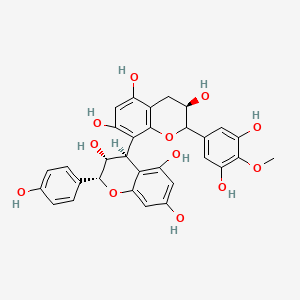Ferroptosis-centered Drug Response Information
General Information of the Drug (ID: ferrodrug0281)
| Name |
Proanthocyanidin
|
||||
|---|---|---|---|---|---|
| Synonyms |
Proanthocyanidin; Proanthocyanidin A; 18206-61-6; Ouratea proanthocyanidin A; (3R)-2-(3,5-dihydroxy-4-methoxyphenyl)-8-[(2R,3R,4R)-3,5,7-trihydroxy-2-(4-hydroxyphenyl)-3,4-dihydro-2H-chromen-4-yl]-3,4-dihydro-2H-chromene-3,5,7-triol; 274678-42-1; Zangrado; CCRIS 9188; SCHEMBL4747623; AKOS015967674; (4,8'-Bi-2H-1-benzopyran)-3,3',5,5',7,7'-hexol, 2'-(3,5-dihydroxy-4-methoxyphenyl)-3,3',4,4'-tetrahydro-2-(4-hydroxyphenyl)-, (2R-(2alpha,3alpha,4beta(2'R*,3'R*)))-; J-011651; (2R,3R,4R)-4-[(3R)-2-(3,5-dihydroxy-4-methoxyphenyl)-3,5,7-trihydroxychroman-8-yl]-2-(4-hydroxyphenyl)chroman-3,5,7-triol; 2-(3,5-Dihydroxy-4-methoxyphenyl)-8-[3,5,7-trihydroxy-2-(4-hydroxyphenyl)-3,4-dihydro-2H-chromen-4-yl]-3,4-dihydro-2H-chromene-3,5,7-triol
Click to Show/Hide
|
||||
| Structure |
 |
||||
| Formula |
C31H28O12
|
||||
| IUPAC Name |
(3R)-2-(3,5-dihydroxy-4-methoxyphenyl)-8-[(2R,3R,4R)-3,5,7-trihydroxy-2-(4-hydroxyphenyl)-3,4-dihydro-2H-chromen-4-yl]-3,4-dihydro-2H-chromene-3,5,7-triol
|
||||
| Canonical SMILES |
COC1=C(C=C(C=C1O)C2C(CC3=C(O2)C(=C(C=C3O)O)C4C(C(OC5=CC(=CC(=C45)O)O)C6=CC=C(C=C6)O)O)O)O
|
||||
| InChI |
InChI=1S/C31H28O12/c1-41-31-20(37)6-13(7-21(31)38)28-22(39)10-16-17(34)11-19(36)25(30(16)43-28)26-24-18(35)8-15(33)9-23(24)42-29(27(26)40)12-2-4-14(32)5-3-12/h2-9,11,22,26-29,32-40H,10H2,1H3/t22-,26-,27-,28?,29-/m1/s1
|
||||
| InChIKey |
JPFCOVZKLAXXOE-XBNSMERZSA-N
|
||||
| PubChem CID | |||||
Full List of Ferroptosis Target Related to This Drug
Unspecific Target
| In total 1 item(s) under this Target | |||||
| Experiment 1 Reporting the Ferroptosis-centered Drug Act on This Target | [1] | ||||
| Responsed Disease | Spinal cord injury | ICD-11: ND51 | |||
| Pathway Response | Fatty acid metabolism | hsa01212 | |||
| Ferroptosis | hsa04216 | ||||
| Cell Process | Cell ferroptosis | ||||
| In Vitro Model | mSCs (Mouse splenocytes) | ||||
| In Vivo Model |
Female C57BL/6 mice (10-12 weeks old, weighing 24-26 g) were used in this study. Mice were randomly assigned to the following groups: (1) Sham group, subjected to laminectomy operation; (2) SCI group, which underwent SCI with intraperitoneal injection (i.p.) of saline; (3) PACs5 group (5 mg/kg PACs), which underwent SCI with i.p. of 5 mg/kg PACs solved in saline; (4) PACs10 group (10 mg/kg PACs), which underwent SCI with i.p. of 10 mg/kg PACs solutions.
Click to Show/Hide
|
||||
| Response regulation | Proanthocyanidins (PACs) treatment significantly decreased the levels of iron, TBARS, ACSL4, and Alox15B, while increased the levels of GSH, GPX4, Nrf2, and HO-1 in traumatic spinal cords. Above all, PACs improved the locomotive function of spinal cord injury (SCI) mice. These results suggest that PACs might be potential therapeutics for SCI repair by inhibiting ferroptosis in SCI. | ||||
